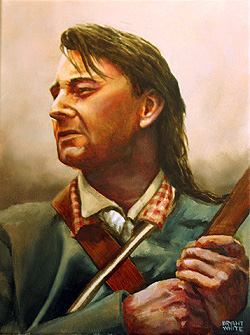People
Caleb Phillips
1755-1829

Caleb Phillips
© 2008 Bryant White
Caleb Phillips was the eighth child of Thomas and Catharine (Liscomb) Phillips of Ashfield. His father was the second settler in Ashfield and was prominent in town affairs, serving as a selectman and a member of the church council. Caleb was in his early 20s when the Revolution broke out. He performed several militia tours between 1776 and 1779, including serving in a company of militia under Captain Agrippa "Grip" Wells of Greenfield. Philips married Sally Green in 1781 and was 30 years old in the winter of 1786/7. His exact movements during the Massachusetts Regulation, or Shays' Rebellion, are not fully documented, but it is likely that he marched with the company commanded by his former captain, Agrippa Wells. It was this company which took the brunt of the artillery barrage at the United States Arsenal at Springfield. Caleb apparently fled back to Ashfield in the wake of the failed Arsenal assault. He took the government's offer of a pardon to all rank and file "insurgents" who came forward, surrendering his weapon and taking the oath of allegiance in the winter of 1787. (His gun was returned to him the following December.) Seth Catlin, a local Justice of the Peace, announced that he would be at Reuben Wells' tavern in Greenfield to administer oaths to any man who came forward. Caleb may have been among them; his name does not appear in the Ashfield record of men who took the oath there. Greenfield was a relatively friendly place to take the oath; it had turned out two companies of Regulators as well as sending pro-government militia to defend the Arsenal. Caleb Phillips left Ashfield shortly after Shays' Rebellion, joining many other people in western Massachusetts who moved to New York in the late 1780s and 90s. He died in Phelps, New York, in 1829.
About This Narrative
Note: All narratives about people are, to the extent possible, based on primary and secondary historical sources.
See Further Reading for a list of sources used in creating this narrative. For a discussion of issues related to telling people's stories on the site, see: Bringing History to Life: The People of Shays' Rebellion
| Print | Top of Page